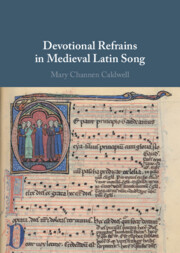Book contents
- Devotional Refrains in Medieval Latin Song
- Devotional Refrains in Medieval Latin Song
- Copyright page
- Dedication
- Contents
- Figures
- Tables
- Music Examples
- Acknowledgments
- Abbreviations
- Introduction: Latin Song and Refrain
- 1 Latin Song and Refrain in the Medieval Year
- 2 Refrains and the Time of Song
- 3 Singing the Refrain
- 4 Remembering Refrains
- 5 Retexting Refrains
- 6 Conclusion
- Appendix Latin Refrain Songs
- Bibliography
- Index of Works
- General Index
5 - Retexting Refrains
Latin and Vernacular Refrains in Contact
Published online by Cambridge University Press: 24 March 2022
- Devotional Refrains in Medieval Latin Song
- Devotional Refrains in Medieval Latin Song
- Copyright page
- Dedication
- Contents
- Figures
- Tables
- Music Examples
- Acknowledgments
- Abbreviations
- Introduction: Latin Song and Refrain
- 1 Latin Song and Refrain in the Medieval Year
- 2 Refrains and the Time of Song
- 3 Singing the Refrain
- 4 Remembering Refrains
- 5 Retexting Refrains
- 6 Conclusion
- Appendix Latin Refrain Songs
- Bibliography
- Index of Works
- General Index
Summary
Chapter 5 identifies the refrain as an axis between Latin and vernacular song, focusing on what the concentration of contrafacts in three unique manuscripts (the St-Victor Miscellany, Engelberg Codex, and Red Book of Ossory) reveals concerning the interpenetration of song cultures and their languages across Europe. Refrain songs in these notated and unnotated sources feature parallel forms of scribal evidence and intervention that illustrate long-standing interactions between Latin and vernacular refrains through contrafacture and offer insight into the multilingual communities behind the Latin refrain song repertoire. Two of the three sources - the St-Victor Miscellany and Red Book of Ossory - transmit only unnotated songs, moreover, while the Engelberg Codex lacks notation for six of its nine marginally annotated songs. This chapter suggests that the vernacular fragments, or refrains, behave in many ways like musical notation; knowledge of the melody attached to a given vernacular text (typically a refrain) enables the musical realization of the Latin poem. Independently of one another, the St-Victor Miscellany, Engelberg Codex, and the Red Book of Ossory treat the Latin and vernacular refrain in similar ways by using the refrain to initiate formal links across language and generate musical meaning in the absence of notation.
Keywords
- Type
- Chapter
- Information
- Devotional Refrains in Medieval Latin Song , pp. 190 - 230Publisher: Cambridge University PressPrint publication year: 2022

